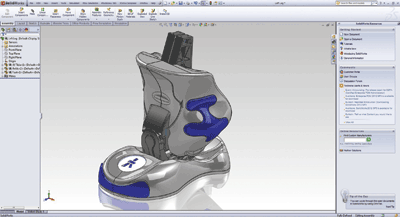Innovating robotic design with 3D CAD software
How various industries and others rely on 3D CAD solutions to meet unique challenges
BY MARIE PLANCHARD
Director of Education Markets
SolidWorks
www.solidworks.com
Robotics has revolutionized the way people work today and has become more commonplace. Robot designers create highly complex mechatronics systems that successfully integrate electrical, mechanical and information-processing components to meet the unique challenges faced by a number of industries including warehouse, surgical, manufacturing, research, and education. As the demand for this technology increases, so does the need for a streamlined design and development process to deliver solutions on time and within a specific budget.

Fig. 1: Three-dimensional CAD tools advances the design of the NAO robot to meet the specific field needs, including autism research and helping elderly people become more mobile.
The robotic design process has changed significantly over the past five years and so has the technology to keep up with the increased demand. Three-dimensional CAD solutions have maintained the pace of advancement as more and more industries integrate robotics (see Fig. 1 ). Using these solutions, organizations can visualize material selection and streamline product design while estimating costs and innovate across all industries.
Material selection is critical in robot design. The specific characteristics of any material not only determine mass, but also affect how it responds to different forces and acceleration. When designers select a material using 3D CAD software, they can virtually simulate the robot’s capabilities from the beginning of the design stage.
Using 3D CAD solutions also helps designers innovate even under extreme budget constraints. Robotic design has evolved from a traditional sequential approach, with a physical prototype used to validate and optimize design, to a virtual simulation that eliminates the need for multiple prototypes. With just a few clicks of a mouse, engineers can select materials and simulate the integrated mechanical and control design from their computer, eliminating the need for multiple physical prototypes.
Robotic technology is increasingly being integrated into the workforce across a wide variety of disciplines from operating warehouses to assisting in partial knee resurfacing. Following are a few examples of how these industries and others rely on 3D CAD solutions to meet unique challenges:
Warehouse
Kiva Systems (North Reading, MA) creates autonomous, mobile robots for distribution centers to help companies simplify operations and reduce costs. Kiva relies on 3D CAD solutions to design and configure robots for each customer’s warehouse structure.
Robots are customized to meet an array of requirements from their customers, including office supply providers to an online shoe store. Kiva designers can simplify custom configurations using 3D CAD software and optimize designs for strength and material economy. Engineers also use this solution to streamline the communication of ideas and manage revisions.
Surgical
MAKO Surgical (Fort Lauderdale, FL) provides technology to help surgeons use less invasive surgical technique for partial knee resurfacing. MAKO leverages 3D CAD solutions to provide advanced surfacing tools to its customers, thanks to powerful large assembly and motion simulation capabilities. MAKO shortened its development cycles, reduced its prototyping costs, improved its rapid prototyping capacity and enhanced its photorealistic rendering capabilities.
Manufacturing
A robotics industry leader since 1982, FANUC Robotics (Rochester Hills, MI) designs, engineers, and manufactures industrial robots and robotic systems. Using 2D software, parts had to be molded by scratch, adding two extra days to the design process just to get the model to mesh. Using 3D CAD design analysis software, FANUC standardized mechanical design to improve productivity.
The software also optimized design creating greater productivity performing analysis, finding errors and changing dimensions of parts where required. With simulation and the 3D CAD’s optimization features they were able to create a more flexible design and verify its performance under acceptable stress levels to meet the required design life.
All this can be accomplished in only two days instead of the one month required with the former solution. Motion software was also used to understand and predict robot performance under previously untested conditions to ensure the robots work properly for their customers’ applications.
Research
Aldebaran Robotics (Paris, France) designs, produces, and commercializes autonomous humanoid robots to work for the well-being of humans (see Fig. 2 ). This platform is used globally to aid in research topics in robotics, computer science, human-machine interaction and the social sciences.
President and CEO Bruno Maisonnier looks for 3D CAD software experience when hiring his designers. He believes this easy-to-use technology advances the design and modification of the NAO robot to meet the specific field needs, including autism research and helping elderly people become more mobile.

Fig. 2: Aldebaran Robotics designs, produces, and commercializes autonomous humanoid robots to work for the well being of humans.
Education
To keep up with its innovative reputation, Massachusetts Institute of Technology (MIT) (Cambridge, MA) relied on 3D CAD solutions when implementing a robotics design contest. The software played a key role in tightening the curriculum to just six sessions, allowing students to begin individual robot design and production in one 15-week semester. Students experienced an advanced learning environment by experimenting with sophisticated manufacturing equipment.
In Virginia Tech’s Robotics and Mechanisms Laboratory (RoMeLa) (Blacksburg, VA), undergraduate and graduate students, as well as faculty advisors, conduct robotic research using 3D CAD solutions. This application shortened design time and reduced errors to help students create award-winning projects, including the first full-sized, autonomous humanoid robot in the United States.
In every scenario, good planning is crucial in the development stage. Engineers must evaluate the robot by the task it must perform and ask questions. What is the design goal? What is the cost and price point? What has been done before? Using 3D CAD solutions can help to visualize these questions and allow designers to create robots that support their specific industry’s needs. ■
Advertisement
Learn more about SolidWorks





